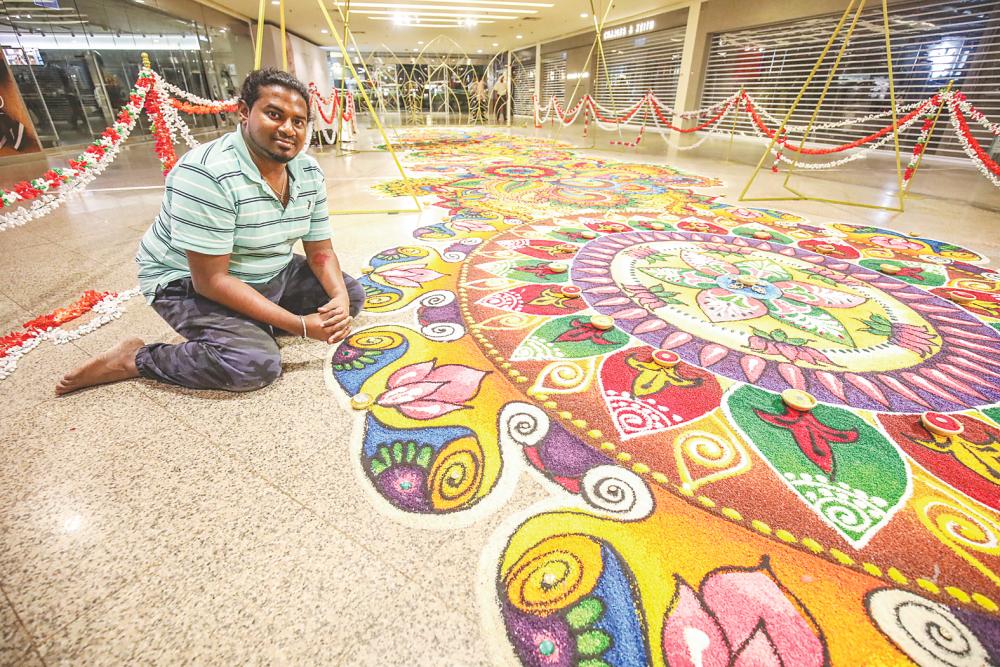IT WAS 11pm on a Sunday and The Gardens Mall, which was usually crowded with people, looked deserted. All the shops were closed, the customers had all gone home and you could hear a pin drop in the silence.
But the shopping centre was not totally empty. On the ground floor, Ruben Prakash and seven of his staff were kneeling on the floor, coloured rice gently slipping from their hands. Slowly, the rice grains began forming a beautiful swan.
The Gardens Mall had hired Ruben and his team to create something colourful and spectacular in preparation for the upcoming Deepavali festivities.
“We can only work from 11pm to 9am, when the shopping mall is closed and there are no customers,” said Ruben, 33. “Once the shops begin opening at 9am, we have to stop whatever we are doing and come back at night.”
It usually takes the team at least three days to complete one of the beautiful kolams, a traditional Indian art form which is also referred to as rangoli.
Ruben, who has been drawing kolam professionally for the last 18 years, explained: “Rangoli is derived from the Sanskrit word ‘rangavalli’, which means a creative expression of art through the use of colour.
“Indirectly, rangoli is an artistic celebration of colours. Rangoli is an auspicious necessity in most Indian religious rituals.”
During the Deepavali season, it is common to see kolam patterns on the floors of most shopping centres in Malaysia, and also on the floors of the homes of Hindus celebrating the festival.
“There is a reason why kolam is drawn using rice grains,” Ruben said. “It is to invite small animals like birds and ants to eat them. It just goes to show that during festive occasions, we not only feed our guests, but also small creatures.”
Ruben has been drawing kolam at The Gardens Mall for the past six years. Last year, his design featured a colourful parrot.
“I never repeat my designs,” he said. “This year, it is based on the theme ‘hamsa’, which in Sanskrit means an aquatic bird of passage.
“Scholars have translated [this to] refer to a goose, swan, or flamingo.”
For this year’s design, Ruben settled on the swan, which he points out is a creature considered to be a spiritual symbol in Indian and Southeast Asian cultures.
Some 300 kilogrammes of rice was used to create the swan. Before the kolam was drawn, the rice was soaked in colourful dyes and left to dry for a week.
“If the rice has not dried well, it will have fungus, and we cannot use fungus-infected rice to draw a kolam,” Ruben said.
Ruben only uses natural colouring on his rice. This is because after his designs have been displayed for a month, he will collect all the rice grains and donate them to local chicken farms.
“I do not want to waste the rice,” he said. “If I used chemical colouring, I could not feed the rice to the animals.”
Ruben was also kind enough to take me to see the kolam he was completing at the adjoining Mid Valley Megamall. There, he had drawn an abstract flower design using the vibrantly-coloured rice grains.
I watched as he put the finishing touches to this glorious art piece.
Ruben first learned to draw kolam when he was 15 years old. He grew up in a home run by the Pure Life Society (PLS), an organisation that provides shelter and assistance to needy children.
Creating kolam was one of the society’s activities. The vibrant colours attracted him to dabble in kolam drawing, and helped develop his interest in the arts, leading him to study graphic design.
“Through my graphic course, I learned more about colour toning, and it helped me to make my kolam more exciting.”
He first started drawing kolam for weddings, and later received offers to draw them in shopping centres.
“Drawing a kolam for a wedding and for a shopping centre is different,” he explained.
“For weddings, the kolam designs are small, while in shopping centres, the kolam has to be huge and intricate enough to attract the attention of customers – and that takes a lot of energy and work.”
Even after 18 years of drawing kolam, Ruben said he will never get bored of doing it, adding that “colours have always fascinated me”.









